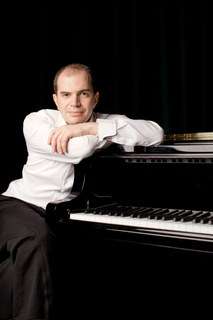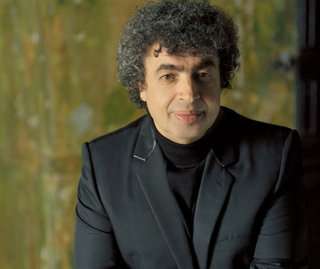|
Back
Tha Anguish and the Passion New York
Avery Fisher Hall, Lincoln Center
10/17/2013 - & October 18, 19, 2013
Sergei Rachmaninoff: Rhapsody on a Theme of Paganini, opus 43
Dmitri Shostakovich: Symphony No. 11, The Year 1905, opus 103
Kirill Gerstein (Pianist)
New York Philharmonic Orchestra, Semyon Bychkov (Conductor)

K. Gerstein (© Marco Borggreve)
Russian music has a propensity for the pictorial. But last night’s two Russian pictures must have left many in the audience about the pair of pictures. After the opening Rachmaninoff, I longed to take a leisurely stroll under the moonlight in Central Park. At the end of the Shostakovich, I was burning to visit Brighton Beach, pick out any lingering Czarists among the Russian community and hurl either a glass of vodka or the correct imprecations in their faces.
An explanation is necessary.
This was the third night in a row for Rachmaninoff, but where the Third Concerto was serious, and the Vespers ecclesiastical, the Rhapsody on a Theme of Paganini was given an off-putting quality, a leisurely throwaway performance by Kirill Gerstein.
Mind you, the stately Mr. Gerstein is a fine pianist when it comes to the notes and bolts of the piano. His fingering was perfect, he whirled up and down the piano as if he was a kid playing Chopsticks, and indeed, he had the rhapsodic spirit. But such affability, such unconcern with the hazards in front of him was sometimes rather disconcerting.
True, the popularity of the Rhapsody is based upon its “niceness”, as a gentle diversion for a formidable pianist (i.e. the composer himself). But while the composer deleted the phrase “in the form of variations” from the title, these are indeed 24 different variations with various sonorities, various forms of emotion. Mr. Gerstein , perhaps delighted to have such an approving audience before he began, played the piece with a sense between “blah” and “blasé”, wowing the audience with his fireworks, giving room for the famed 18th Andante Cantabile variation, but otherwise simply enjoying himself.
And if he played this more as a divertissement than a rhapsody...well, he delighted in his own brilliance. And honestly, we couldn’t help delighting in his carefree performance as well. Conductor Semyon Bychkov, rightly a favorite on his rare visits to New York, is a master of the crisp sforzandi. His sharp attacks at the beginning did more than complement Mr. Gerstein, it actually provided the color for Mr. Gerstein’s masterly drawing.

S. Bychkov (© Sheila Rock)
But for sheer, absolute, fiery, conflagrant color, little could beat Mr. Bychkov’s performance of Shostakovich’s Symphony Number 11, a work which Sergei Eisenstein could have used for his silent masterpiece, October.
Yes, we all are supposed to know that Shostakovich had his secret musical mantras, his codes for what his feelings really were about the 1905 prelude to the Russian Revolution. Perhaps, because it was written about the time of the Russian suppression of the Hungarian Revolution, he might have been referring to this. But far more essential, Shostakovich was honestly and truly, all his life, an honest Russian patriot. Patriotism to him was not Stalinist or Leninist politics, it was the profound, mystical belief in Mother Russia.
Equally important was that Shostakovich drew the most agonizing portraits of Russia, true tableaux in this work. The opening mists in Saint Petersburg echo the opening of Mussorgsky’s Khovanshchina. The gathering of the workers and their massacre, with the substantial quotes from Russian folk music, was an opera without actors. In Memoriam was as heartfelt as his string quartet slow movements. And the finale...well, that finale, the triumph of the people, was, as in all Shostakovich, the epitome of unshackled grandeur.
How would Semyon Bychkov have compared with Valery Gergiev, who was here last week with the Mariinsky Orchestra? Best not to hypothesize. Gergiev often exaggerates those climaxes, his fluttering fingers bringing out the triumph and tragedy as in a El Greco distortion. Semyon Bychkov certainly didn’t hesitate to make the trumpets ring, to make the whole battery of percussion pound with unremitting fury. (I was ready to make a citizen’s arrest for the crime of assault and battery.) But Mr. Bychkov never needed to exaggerate the composer’s tone-painting.
The morning mist with the wake-up trumpet calls and timpani rumbles, was taken more quickly than the composer’s Adagio. But this morning was not a Peer Gynt sunrise or orchestral weather report. It was a morning of urgency, of importunity. Where Mr. Gergiev might have leaned in his orchestra, to distillate every emotion from the orchestra, Mr. Bychkov stood a bit apart, allowing the New York Philharmonic brass, winds and percussion to fight the battle, and to allow the shining strings of the orchestra to bring forth the third-movement memorial
I doubt that any of the dozen-odd great conductors of today would shun from giving an all-encompassing performance, and Mr. Bychkov, with the benefit of being a guest conductor of the Saint Petersburg Orchestra, is among the best. It was a movement of alacrity and emotion, of outer euphoria and inner passion.
Mr. Gerstein’s opening work was, yes, a walk in the park, a romp amongst squirrels and robins and oak-shrouded Central Park paths. Mr. Bychkov erased such bucolic dreams, instead leading the Philharmonic with glory, grandeur and frequently Homeric anguish.
Harry Rolnick
|